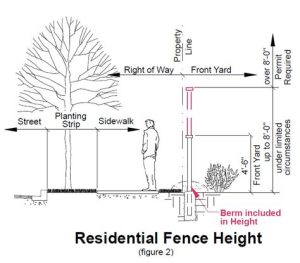Learn how to navigate local zoning regulations, permit requirements, and application processes for fence installation to avoid penalties for non-compliance.When considering the installation of a fence on your property, understanding the legal nuances is crucial to avoid costly mistakes. Many homeowners assume that putting up a fence is a straightforward task, but local zoning regulations can significantly influence your project. Each municipality may impose specific requirements and restrictions, making it essential to determine whether a permit is necessary in your area. This blog post will guide you through the ins and outs of fence installation permits, detailing the process for applying, common restrictions you might encounter, and the potential consequences of forging ahead without the proper permissions. By equipping yourself with this knowledge, you can ensure a smooth and compliant fencing project that enhances your property and adheres to local laws.
Understanding local zoning regulations
When it comes to installing a fence, one of the first steps you need to take is to understand your local zoning regulations. These regulations can vary significantly based on your location, and they dictate what you can and cannot do regarding your property boundaries.
Most local zoning regulations are established by city or county governments to ensure that developments are in line with community standards and land use policies. They often address aspects such as the height, material, and location of fences. For example, some areas may limit fence heights to a maximum of six feet, while others may require that certain materials—like chain link or wood—be used for visibility or aesthetic reasons.
Additionally, it’s essential to check whether your property is subject to Homeowners Association (HOA) rules, as these may impose more stringent guidelines than local zoning laws.
Determining permit requirements for your fence
When it comes to installing a fence, understanding whether you need a permit is crucial. Different local jurisdictions have varying requirements, and the process can sometimes feel overwhelming. Here’s a simple guide to help you determine if a permit is necessary for your fence installation project.
First and foremost, you should check with your local zoning office. They can provide you with specific information regarding the type of fence you wish to install and whether a permit is required based on your property’s zoning classification. Most municipalities have their regulations listed on their websites, making it easy to access the information you need.
- Height: Taller fences often require a permit.
- Material: Some materials might have specific restrictions.
- Location: Fences built near property lines or sidewalks may require approval.
- Type: Certain types, like pool fences, usually have stricter regulations.
Always err on the side of caution; if in doubt, it’s advisable to consult your local authorities to avoid any potential complications down the road.
Process for applying for a fence installation permit
When considering installing a fence on your property, understanding the process for applying for a fence installation permit is crucial. This process varies by location, but generally follows a few standard steps which investors and homeowners alike should be aware of.
The first step is to contact your local zoning office or municipal government. They will provide you with the specific requirements and guidelines associated with fence permits in your area. It’s important to gather all the necessary information, including any forms that need to be completed and any associated fees.
Typically, the application will require you to provide details about the type of fence you intend to install, including its height, material, and purpose. You may also need to submit a site plan that outlines the dimensions of your property along with where the fence will be placed. Once your application is complete, you can submit it for review. It’s important to be aware that the review process may take some time, so plan accordingly to avoid any disruptions to your project.
| Step | Description |
|---|---|
| 1 | Contact Local Authority – Reach out to the zoning office for guidelines. |
| 2 | Complete Application – Fill out the necessary forms and gather required documents. |
| 3 | Submit Application – Turn in your completed application for review. |
| 4 | Await Approval – Be prepared for wait times and possible follow-up information requests. |
Common restrictions and guidelines for fence permits
When you’re planning to install a fence, it’s crucial to understand the common restrictions and guidelines associated with fence permits in your area. Each locality can have specific rules that govern the height, style, and type of materials used for fencing. Ignoring these guidelines can lead to fines or forced removal of the installed fence.
- Height Limits: Many areas have restrictions on how tall a fence can be, particularly when it comes to front yards. Generally, fences in the front cannot exceed 4 feet, while backyards may allow higher fences.
- Material Restrictions: Some neighborhoods have regulations regarding the types of materials that can be used. For example, chain-link fences may be prohibited in certain residential areas, while wooden fences may have guidelines for the type of wood that can be used.
- Setback Requirements: Local regulations may require that fences be set back a certain distance from the property line. This distance can vary, but it’s important to check local laws to ensure compliance.
In addition to these restrictions, you may also need to adhere to homeowners’ association (HOA) guidelines if you live in a community with one. Associations often have their own rules that may be stricter than local zoning laws. Therefore, it’s wise to consult your HOA for any additional requirements.
Consequences of installing a fence without a permit
Installing a fence without obtaining the proper permit can lead to serious repercussions for homeowners. In many jurisdictions, local zoning regulations outline the requirements regarding property boundaries and the types of structures that can be erected. Failing to adhere to these regulations may result in significant fines.
Moreover, if a fence is installed without a permit, it may be subject to removal. Local authorities may require the homeowner to dismantle the illegally constructed fence, leading to wasted time, effort, and financial resources. It’s essential to understand that the impact of not having a permit extends beyond immediate penalties.
In addition to fines and removal, installing a fence without a permit could potentially create conflicts with neighbors. Disputes can arise regarding property lines, visibility issues, or the fence’s height. Such situations not only cause tension within the community but can also lead to legal disputes, which are both costly and time-consuming.
Frequently Asked Questions
What factors determine if a fence installation requires a permit?
Factors include local zoning laws, height restrictions, and the type of material used for the fence.
How can I find out the specific permit requirements for my area?
You can check with your local city or county building department, or visit their official website for guidance on permit requirements.
Are there any common types of fences that typically require a permit?
Yes, common types like solid wood, chain-link fences above a certain height, and privacy fences usually require a permit.
What penalties might I face for installing a fence without a permit?
Penalties may include fines, orders to remove the fence, or additional fees for after-the-fact permits.
Is there a difference in permit requirements for residential vs. commercial properties?
Yes, commercial properties often face more stringent regulations and require more detailed permits compared to residential properties.
Can I appeal a denied fence permit application?
Yes, most local agencies have an appeal process in place where you can request a review of your application.
What documents do I typically need to submit for a fence permit application?
Documents usually include a site plan, property survey, and any required approvals from homeowners associations, if applicable.




